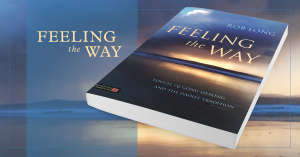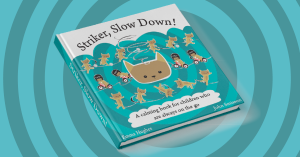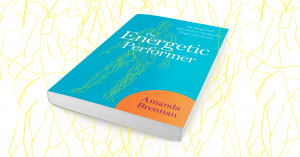 Following the recent release of Feeling the Way, author Rob Long participated in a Q&A with his colleague Shelagh Brady to discuss his new book and what ‘healing’ means for him.
Following the recent release of Feeling the Way, author Rob Long participated in a Q&A with his colleague Shelagh Brady to discuss his new book and what ‘healing’ means for him.
Author: Singing Dragon
Sitting on a Chicken: Extract
To celebrate the release of Sitting on a Chicken by Michael Chissick, we are releasing an extract from the book, featuring four interactive yoga games and poses you can use with your children or pupils!
To download the extract please click here.
Learn more about Sitting on a Chicken here.
Michael Chissick has written several books for children, published by Singing Dragon, please find them here.
How can yoga help children?
 We caught up with Emma Hughes, the author of ‘Striker, Slow Down!‘ and ‘Go, Yogi!’ to discuss her books, how children can benefit from practicing yoga and how she discovered yoga.
We caught up with Emma Hughes, the author of ‘Striker, Slow Down!‘ and ‘Go, Yogi!’ to discuss her books, how children can benefit from practicing yoga and how she discovered yoga.
Striker, Slow Down! – Colouring Page
To celebrate the release of Striker, Slow Down!, we have released a downloadable colouring page to help children use mindfulness to control their emotions.
Striker, Slow Down! tells the story of Striker the cat, who is unstoppable! He thinks that there is too much fun to be had, and no matter what his mama tells him, he never slows down. One day, a bump to the head brings this busy cat to a standstill. Will Striker finally listen to his mama and learn to make time for a little calmness?
You can use our colouring page with your children or pupils and you can share your finished pages with us on Facebook or Twitter.
To download the colouring page, please click here.
Feeling the Way: What Does it Mean to Heal Someone?
 In this blog by Rob Long, author of Feeling the Way, Long examines what healing means and how it applies to our lives.
In this blog by Rob Long, author of Feeling the Way, Long examines what healing means and how it applies to our lives.
In my new book ‘Feeling The Way’ I make the bold claim that everybody possesses what is commonly called ‘healing hands’. That means you! What appears in the book is a stripped-back, extremely practical how-to guide, based on insights from over twenty years of my own trial and error in the clinic. I have called what I do ‘Qi Sensitivity Healing’, or QHS for short, and whilst much of it is innovative, it also owes a huge debt to ancient Chinese practices, especially those of the Daoists, those progenitors of Acupuncture, herbal medicine and many other instantly recognizable modalities .
Preparing the Body for Work: Working for Coherence

In this blog by Amanda Brennan, author of The Energetic Performer, Brennan provides an overview of her method of acting and how increasing awareness of the body can enhance the acting experience.
I recently ran a series of workshops for professional actors in Santiago, Chile. The course was designed to refine performance skills, explore the craft of screen acting and discover how to create a rich and complex inner life. In my book The Energetic Performer, I refer to the inner life as all that moves with in, thoughts, vibrations of the nervous system, the beat of the heart, the flow of breath, all feelings and emotional expression. Its cultivation is at the heart of screen performance, where the real action is on the inside. To achieve this aim, I began with what I believe is the fundamental necessity: preparing the body for work.
Facial Torment – and resolution
In this second blog post by Thomas Attlee, author of Face to Face with the Face, Attlee expands on his previous blog post ‘Essentials of Cranio-Sacral Integration‘, by expanding on the key points, and again providing the following three case studies: Tooth, Jaw and TMJ Pain; Hearing Loss and Trigeminal Neuralgia.
Fiona was forty-seven and had suffered a lifetime of countless recurrent ear infections, glue ear, severe deafness, extreme pain, burst ear drums, and inability to travel by air. She had been through countless courses of antibiotics, grommets, operations and other treatments without benefit – until she discovered cranio-sacral integration, and her life was transformed – able to hear again, free of pain, able to fly (by aeroplane, that is, not independently – cranio-sacral integration is not quite that miraculous).
Ninety percent of babies and children suffer middle ear infections¹, often leading to glue ear, with potential repercussions on speech and language. Like Fiona, they may receive frequent prescriptions of antibiotics, sometimes grommets and possibly operations, none of which addresses the underlying cause and which may consequently lead to repeated episodes of the condition.
Enjoy Activities in Nature to Cultivate Mindfulness
a blog post by Stephen and Marcia Rath, authors of Qigong for Wellbeing in Dementia and Aging
Mindfulness meditation is the ability to develop one’s awareness of things in the present moment, internal and external, without attaching to the mind’s restless need to judge or think about the experience.
Essentials of Cranio-Sacral Integration (and case studies)
In this blog post by Thomas Attlee, author of Face to Face with the Face, Attlee explains the ‘Essentials of Cranio-Sacral Integration’, providing an overview of the key points, and providing three case studies: Tooth, Jaw and TMJ Pain; Hearing Loss and Trigeminal Neuralgia.
Higgs-boson:
In 2013 Professor Peter Higgs received the Nobel prize for a concept he first proposed in 1964 and for which the experimental proof was finally provided at the CERN laboratory in Switzerland in 2012. Professor Higgs postulated that there is an invisible field pervading the whole universe.
Within quantum physics it has now been established that there is a universal field, a unifying matrix within which everything exists and interacts – every galaxy, star, planet, solid object, living being, molecule, atom, subatomic particle – a field from which particles take their mass.
In the quantum model of cranio-sacral integration, we also perceive a universal field or matrix, within which life on earth has come into being, and each one of us exists as an individual matrix within this wider matrix. We are formed embryologically, developed, maintained and sustained by the biodynamic forces within that field, and every cell, atom, and subatomic particle within our body is an integral part of that wider field.
Inside the Mouse’s House…
by Susan Quayle, author of Mouse’s Best Day Ever
Sitting at the kitchen table were my two children and my daughter’s two friends, who had come over to play. They were having lunch and chattering away as children do, when I heard, “Poppy’s got a reward chart,” after which there was a brief silence, followed by, “for going to the toilet.” I have to admit that this was not exactly what I was expecting to hear. I turned around to join in the conversation, asking “how does that work then?”
